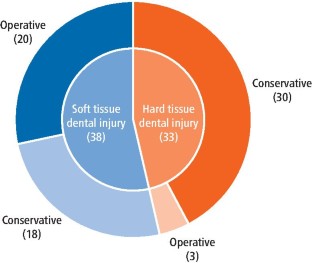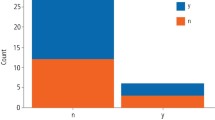Abstract
Introduction In June 2020, the United Kingdom (UK) published guidance on electric scooter (e-scooter) use to ease transport congestion and reduce pollution. This study aims to examine dental injuries sustained during the two years following initiation of the trial.
Methods The research was conducted at a UK, Level 1, supra-regional major trauma centre. All eligible patient records were analysed to identify e-scooter-related dental injuries to the following regions: teeth, periodontium, alveolus, palate, tongue, floor of mouth, frenum, buccal mucosa and lips. To assess significant associations between recorded variables, a Pearson's chi-square test was utilised.
Results Of the 32 patients who experienced a total of 71 dental injuries, 46.5% (n = 33) affected teeth, predominantly upper central incisors (n = 17). ‘Lacerations' (n = 32) and ‘lips' (n = 30) were the most common type and site of soft tissue injuries, respectively. Unprovoked falls by riders accounted for 53.1% (n = 17) of the injuries. There was an overall increase in e-scooter-related dental injuries throughout the two-year period.
Conclusion E-scooters have introduced an additional source of dental trauma. It is imperative health care professionals can also identify signs of head and non-dental injuries when managing such patients. Further studies are warranted allowing for better informed and optimised dental public health interventions.
Key points
-
E-scooters are a new form of transport that can be the cause of hard tissue and soft tissue dental injuries.
-
E-scooter-related dental injuries are often related to head injuries, non-dental injuries and intoxication.
-
The rise in e-scooter-related dental injuries over the two-year period underscores the need for government-instigated e-scooter safety precautions.
This is a preview of subscription content, access via your institution
Access options
Subscribe to this journal
Receive 24 print issues and online access
$259.00 per year
only $10.79 per issue
Buy this article
- Purchase on Springer Link
- Instant access to full article PDF
Prices may be subject to local taxes which are calculated during checkout



Similar content being viewed by others
References
Eilert-Petersson E, Andersson L, Sorensen S. Traumatic oral vs non-oral injuries. An epidemiological study during one year in a Swedish county. Swed Dent J 1997; 21: 55-68.
Kargul B, Çağlar E, Tanboga I. Dental trauma in Turkish children, Istanbul. Dent Traumatol 2003; 19: 72-75.
Bani M, Alacam A, Cinar C. How does dental trauma affect the quality of life in Turkish families? Oral Health Prev Dent 2017; 15: 563-567.
Borum M K, Andreasen J O. Therapeutic and economic implications of traumatic dental injuries in Denmark: an estimate based on 7549 patients treated at a major trauma centre. Int J Paediatr Dent 2001; 11: 249-258.
Lee J Y, Divaris K. Hidden consequences of dental trauma: the social and psychological effects. Pediatr Dent 2009; 31: 96-101.
Glendor U. Epidemiology of traumatic dental injuries - a 12 year review of the literature. Dent Traumatol 2008; 24: 603-611.
Petti S, Glendor U, Andersson L. World traumatic dental injury prevalence and incidence, a meta-analysis-one billion living people have had traumatic dental injuries. Dent Traumatol 2018; 34: 71-86.
Brownson A B, Fagan P V, Dickson S, Civil I D. Electric scooter injuries at Auckland City Hospital. N Z Med J 2019; 132: 62-72.
Moftakhar T, Wanzel M, Vojcsik A et al. Incidence and severity of electric scooter related injuries after introduction of an urban rental programme in Vienna: A retrospective multicentre study. Arch Orthop Trauma Surg 2020; 141: 1207-1213.
UK Government. Rental e-scooter trials to be allowed from this weekend. 2020. Available at https://www.gov.uk/government/news/rental-e-scooter-trials-to-be-allowed-from-this-weekend (accessed August 2023).
City Monitor. Where are the largest cities in Britain? 2023. Available at https://citymonitor.ai/environment/infrastructure/where-are-largest-cities-britain-1404 (accessed August 2023).
BBC. Birmingham e-scooter trial extended to May 2024. 2022. Available at https://www.bbc.co.uk/news/articles/c4ne265lvzro (accessed August 2023).
Barker M, Pepper T, Dua R, Fan K. Electric scooters: convenient transport or ED Headache? Br J Oral Maxillofac Surg 2022; 60: 199-200.
Aurora F, Cove G, Sandhu P, Thomas S J, Gormley M. Oral and maxillofacial injuries from Electric Scooters in Bristol: A retrospective observational study. Br J Oral Maxillofac Surg 2022; 60: 837-840.
UK Parliament. Regulating electric scooters (e-scooters). 2021. Available at https://commonslibrary.parliament.uk/research-briefings/cbp-8958/ (accessed August 2023).
Harbrecht A, Hackl M, Leschinger T et al. What to expect? injury patterns of electric scooter accidents over a period of one year - a prospective monocentric study at a Level 1 trauma center. Eur J Orthop Surg Traumatol 2021; 32: 641-647.
Kobayashi L M, Williams E, Brown C V et al. The e-merging e-pidemic of e-scooters. Trauma Surg Acute Care Open 2019; DOI: 10.1136/tsaco-2019-000337.
Jones K, Parkin J, Rathod N, Bhatt V. Oral and maxillofacial injuries associated with e-scooter use at Broomfield Hospital: A cohort study of 24 months of data since e-scooter legalisation in the UK. Br Dent J 2023; DOI: 10.1038/s41415-023-5506-5.
Shiffler K, Mancini K, Wilson M, Huang A, Mejia E, Yip F K. Intoxication is a significant risk factor for severe craniomaxillofacial injuries in standing electric scooter accidents. J Oral Maxillofac Surg 2021; 79: 1084-1090.
Bourguignon C, Cohenca N, Lauridsen E et al. International Association of Dental Traumatology Guidelines for the management of traumatic dental injuries: 1. Fractures and luxations. Dent Traumatol 2020; 36: 314-330.
Salarić I, Tikvica Medojević D, Baždarić K et al. Primary school teachers' knowledge on tooth avulsion. Acta Stomatol Croat 2021; 55: 28-36.
NHS England. A&E Attendances and Emergency Admissions. Available at https://www.england.nhs.uk/statistics/statistical-work-areas/ae-waiting-times-and-activity/ (accessed August 2023).
Trivedy C, Kodate N, Ross A et al. The attitudes and awareness of emergency department (ED) physicians towards the management of common dentofacial emergencies. Dent Traumatol 2011; 28: 121-126.
Author information
Authors and Affiliations
Contributions
Junaid Rashid: data extraction, data analysis, data interpretation, drafting of the article and final approval. Rajeevan Sritharan: data extraction, data analysis, data interpretation, drafting of the article and final approval. Sophie Wu: conception of idea, data analysis, data interpretation, illustrations, drafting of the article and final approval. Kevin McMillan: conception of idea, data interpretation, critical revisions, final approval, and guarantor of the manuscript.
Corresponding author
Ethics declarations
The authors report no conflicts of interest. Formal ethical approval was not required as this was a retrospective cohort study. Approval was granted by the Clinical Audit and Research Management System which allowed a unique ID to be created for each of the two years of the study. This ID allowed a health informatics request to be completed to identify suitable patients from a dataset which was retrospectively analysed. The collected data was completely anonymised and non-identifiable, thus not requiring patient permissions.
Data availability
The datasets generated and/or analysed during the current study are available from the corresponding author on reasonable request.
Additional information
The original online version of this article was revised.
When initially published, the Fig 1 caption read: ‘Graph showing proportion of soft tissue injuries, dental injuries and their management'. This should have read ‘Graph showing proportion and management of hard and soft tissue dental injuries sustained'.
When initially published, there were errors in certain values within the abstract and main text. These have now been corrected.
Finally, when initially published, an incorrect version of Figure 3 was displayed, the values have been updated.
Rights and permissions
Springer Nature or its licensor (e.g. a society or other partner) holds exclusive rights to this article under a publishing agreement with the author(s) or other rightsholder(s); author self-archiving of the accepted manuscript version of this article is solely governed by the terms of such publishing agreement and applicable law.
About this article
Cite this article
Rashid, J., Sritharan, R., Wu, S. et al. E-scooter-related dental injuries: a two-year retrospective review. Br Dent J (2024). https://doi.org/10.1038/s41415-024-7345-4
Received:
Revised:
Accepted:
Published:
DOI: https://doi.org/10.1038/s41415-024-7345-4


